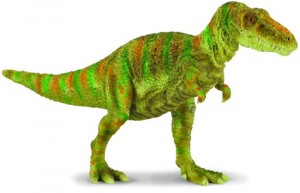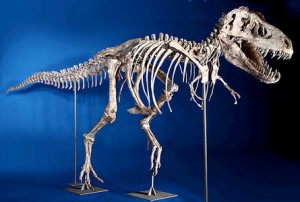Rare T. bataar Bites Back!
Auction House to Help Trace the Origins of T. bataar Fossil Skeleton that was Sold
An almost complete, mounted skeleton of the tyrannosaurid Tarbosaurus bataar, otherwise known as Tyrannosaurus bataar that had been probably collected from Mongolia and sold at auction has run into a legal wrangle. Plans are in place to impose a restraining order on the Tarbosaurus bataar fossil.
Tarbosaurus bataar Fossil
The eight-metre-long skeleton was sold at an auction held in New York by Heritage Auctions on Sunday, May 20th. The winning bid was approximately £630,000 GBP ($1.05 million USD), the buyer has not been disclosed.
To read more about the sale: Tyrannosaurid Fossil Up for Sale.
When the auction was announced, team members at Everything Dinosaur decided to take action. Knowing that it had been illegal to export fossils out of China and Mongolia since 1949, it was assumed that this specimen had been smuggled out of the country without the approval of the appropriate authorities. Everything Dinosaur team members were some of the first people to raise this issue and to sign an online petition that had been organised to try and prevent the sale.
Heritage Auctions
Yesterday, Heritage Auctions, the auction house responsible for the sale, agreed to help the Mongolian Government investigate the ownership and provenance of this Late Cretaceous dinosaur skeleton.
Tarbosaurus (Tarbosaurus bataar, sometimes also referred to as Tyrannosaurus bataar), was an apex predator, measuring in excess of twelve metres in length. The name means “Alarming Reptile” and it is frequently referred to as the “Asian T. rex“, however, how closely related it was to the North American T. rex remains disputed.
Tarbosaurus was formally named and described in 1955. The eminent Russian palaeontologist Evgeny Aleksandrovich Maleev noted how similar fossils found approximately ten years earlier were to Tyrannosaurus rex, accordingly he named this new dinosaur Tyrannosaurus bataar. However, in the mid 1960’s a review of Tyrannosaur skull material and body fossils from Mongolia and China was undertaken and in the light of this new study the name Tarbosaurus bataar was established.
An Illustration of Tarbosaurus
Picture credit: Everything Dinosaur
A Restraining Order
A restraining order had been organised prior to the auction and despite the intercession of the Mongolian President, the auction went ahead ten days ago. However, a state district judge in Texas has granted the Mongolian Government the opportunity to delay the transfer of ownership to the buyer until the provenance of the fossil material has been determined.
Jim Halperin, co-chairman of Heritage Auctions, commented:
“Heritage will enthusiastically strive to arrive at a mutually agreeable outcome, once the President of Mongolia has had a reasonable opportunity to investigate the circumstances.”
The Mongolian President Elbegdorj Tsakhia released a statement yesterday:
“I commend Heritage Auctions and its consignor for assisting with my investigation into the origin and legal ownership of this Tyrannosaurus bataar skeleton.”
A team of inspectors will examine the fossil, which is being stored at a secret location in New York, next month. They will attempt to trace how this fossil came to be at auction, Everything Dinosaur has been led to believe that the fossil was put up for sale by a Dorset based (southern England), private collector. It is likely that this fossil did originate from the Gobi Desert region of Asia. This desert covers northern China and southern Mongolia, although Heritage Auction officials stated that it had not been determined from which country the fossil actually came from.
Mark Norell of the American Museum of Natural History (New York) and a leading palaeontologist stated:
“Since ninety percent of the Gobi Desert is in Mongolia, it was likely found there. Either way, Mongolia and China have the same laws regarding the sovereign ownership of dinosaur skeletons and other artefacts.”
Since both Mongolia and China have prohibited the export of fossil material since 1949, it is likely that this specimen was collected illegally and moved out of the country without permission.
The Tyrannosaurid Skeleton at the Centre of the Dispute
Picture credit: Heritage Auctions
We at Everything Dinosaur hope that this matter is resolved quickly and if any punitive action is taken, let us hope that it acts as a deterrent to help prevent other rare prehistoric animal specimens from being collected illegally.
To view figures and models of tyrannosaurids and other dinosaurs: CollectA Prehistoric Life Figures and Models.



